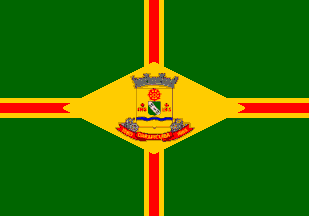 7:10 image by Joseph McMillan
7:10 image by Joseph McMillan
Last modified: 2008-08-02 by ian macdonald
Keywords: sao paulo | carapicuiba | cross (red) | lozenge (yellow) |
Links: FOTW homepage |
search |
disclaimer and copyright |
write us |
mirrors
Other sites:
The flag of Carapicuiba resembles that of Brazil itself: a yellow
lozenge on a green field, with the municipal coat of arms replacing the blue
celestial sphere and the field divided by a yellow-bordered red cross.
(This arrangement is said incorrectly to conform to Portuguese heraldic
tradition.) The cross symbolizes those who discovered the region and the
Christian religion, while the lozenge is said to be a symbol of motherhood.
Yellow and green are the national colors established by the first
emperor, Dom Pedro I. In addition to the usual explanation of these colors
(green for spring and for the Portuguese royal house of Bragança, and yellow
for gold and for the Austrian imperial house of Habsburg, the family of the
emperor's wife Leopoldina), the official description of the flag of
Carapicuiba says green also recalls the triangle on one version of the flag
ascribed to Tiradentes, the most famous participant in the failed rebellion
known as the Inconfidência Mineira of 1789. The municipal website also says the
besiegers of the Bastille used green foliage taken from the trees of the
Palais Royal as their emblem. In addition to gold and the Habsburgs, yellow
is ascribed to "the ardent rays of our live-giving summer." These and the
other colors in the flag are further assigned the symbolism standard for
Brazilian municipal heraldry. As is also common in such flags, the coat of
arms is said to represent the municipal government, the lozenge the city in
which it has its seat, the arms of the cross the radiation of municipal
authority throughout the territory of Carapicuiba, and the green quadrants
formed by the cross the rural areas of the municipality. The measurements
of the flag follow those of the national flag for the proportions and the
lozenge. With the flag itself prescribed as 14 units by 20 units, the red
cross is 0.5 units in width and the yellow border 0.5 units on each side of
the red. The field of the coat of arms is yellow. On the center shield is
a green inescutcheon divided by a bend wavy on which are six sardines, a pun
on the name of the original grantee of the land, Afonso Sardinha. To the
right and left of the inescutcheon are the three letters IHS below the cross
of Christ. The IHS monogram evokes the Society of Jesus (Jesuits) who
founded the original parish. Above the inescutcheon is a red Catherine wheel,
the instrument of martyrdom of the patroness of the municipality. The blue wavy fess below the
inescutcheon is for the Rio Tietê, by which the bandeirantes entered the
Piratininga Valley. The shield is surrounded by gears and sledgehammers for
industry. The scroll is inscribed with the name of the municipality and the
dates of the founding of the settlement (1580) and of the municipal charter (1965).
Source: Official municipal website
Joseph McMillan, 26 August 2002